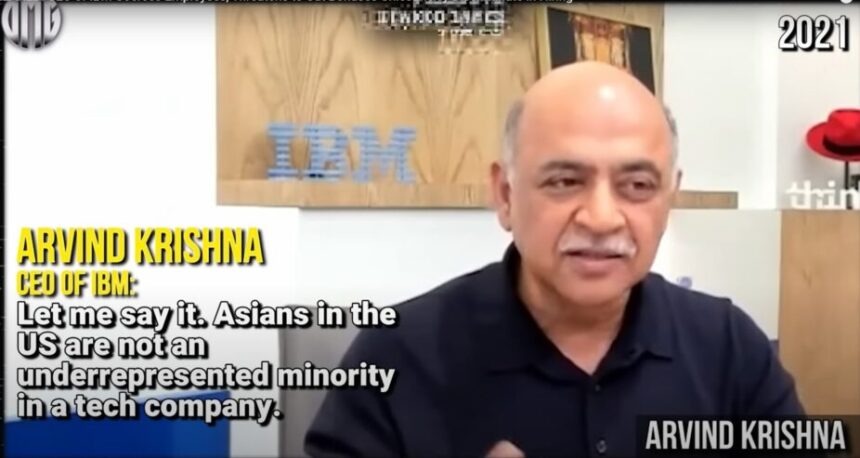A leaked video of IBM Chief Executive Arvind Krishna allegedly coercing his employees to hire based on racial quotas to improve diversity statistics was published in December by undercover investigative journalist James O’Keefe.
“So we take underrepresented and gender. You’ve got to move both forward by a percentage. That leads to a plus on your bonus. By the way, if you lose, you lose part of your bonus,” Krishna said in the video, which was filmed by an IBM insider in 2021. “I’m not trying to finesse this. So for blacks, we should try to get towards 13-point-something percent. On Hispanics, you got to get into the mid-teens.”
Paul Cormier, the chairman of IBM’s software subsidiary, Red Hat, who is also in the video, follows Krishna by adding, “I could name multiple leaders over the last year-plus, that were held accountable [for failing to meet diversity targets] to the point that they’re no longer here at Red Hat.”
O’Keefe’s scoop was largely ignored by the mainstream media and even overlooked by most in conservative media, other than some right-wing populist figures like Tucker Carlson and Steve Bannon. And yet, as O’Keefe described, the video clearly shows IBM executives “using coercion to fire people and take away their bonuses unless they discriminate in the hiring process,” which appears to be a violation of Title VII of the Civil Rights Act of 1964.
In a fair world, the leaked video would be big news. But in current-day America, this kind of racial discrimination is a surprise to no one who has worked for a major American corporation during the last couple of decades. Public corporations regularly publish their diversity statistics in their financial reports, and executives talk internally and externally about the urgent need to make sure the racial and sexual makeup of their workforces matches that of the general population.
A decade ago, I had a short stint in the communications department of one of America’s major corporations. I remember my department head crowing to our assembled team how the company “used to be a bunch of old white guys,” but was now more racially diverse than ever before. He was especially proud to remark that he was the first Hispanic to lead the communications department. This man was a tall, light-skinned Spaniard with a Roman nose who looked like he belonged in a woodcutting depicting Hernán Cortés slaughtering the Aztecs. But since he checked the box for diversity, equity, and inclusion, his mere presence was an indication of progress.
O’Keefe noted that attorneys general in 13 states have warned Fortune 100 companies not to pursue race-based employment practices. Unfortunately, the list of states with such principled legal officials includes only flyover places like Alabama, Mississippi, and Montana. If it were ever to include coastal states where tech giants are located, such as California, Washington, and New York (where IBM is headquartered), that might be something to write home about. Attorneys general in those blue states are about as likely to investigate their states’ top employers for racial discrimination against whites and Asians as they are to crack down on Democratic Party ballot harvesting.
When the Civil Rights Act of 1964 passed, America was nearly 90 percent white. It is now about 60 percent white, and whites will be in the minority by 2045, according to a projection by the Brookings Institute. And make no mistake about who America’s largest corporations are racially discriminating against: whites.
Yes, Asians can make a case that they are also discriminated against, but in practice, Asians are over-represented in U.S. corporations, especially in the technology sector. Asians, who make up 6 percent of the U.S. population, had a median income of $108,700 in 2022, according to the Peter G. Peterson Foundation, which was more than double that of blacks, $46,000 more than Hispanics and $28,000 more than whites.
IBM CEO Krishna, who is Indian, acknowledged this fact in O’Keefe’s leaked call: “Let me say it. Asians in the U.S. are not an underrepresented minority in a tech company.”
Ironically, in the last few years, America’s elite commentariat on both the left and the right has been advising laid-off coal miners in Appalachia to drop their pickaxes and “learn to code.” Since these miners are about 98 percent white males, this helpful suggestion is no more than a sarcastic slap in the face. Everyone knows that while males are last in line for coding jobs: Asians are preferred for that hard work, other minority groups and women get hired to boost the DEI stats.
I live in a suburb of Minneapolis within walking distance of office towers owned by Microsoft, Oracle, and what was once Cray Computers (now Hewlett Packard). A third of my neighbors are from the Indian subcontinent and work at these places. The playgrounds are full of their kids—seeing a non-Indian on the jungle gym is rare. For a time, a shrine to the eight-armed Hindu monkey god Hanuman was a few doors down from me. Almost all these people hold H-1B vias, which means that a U.S. corporation has invited them here because these companies claim they “cannot otherwise obtain needed business skills and abilities from the U.S. workforce,” according to the U.S. Labor Department.
From my own experience and O’Keefe’s leaked videos, I find that hard to believe.

Leave a Reply